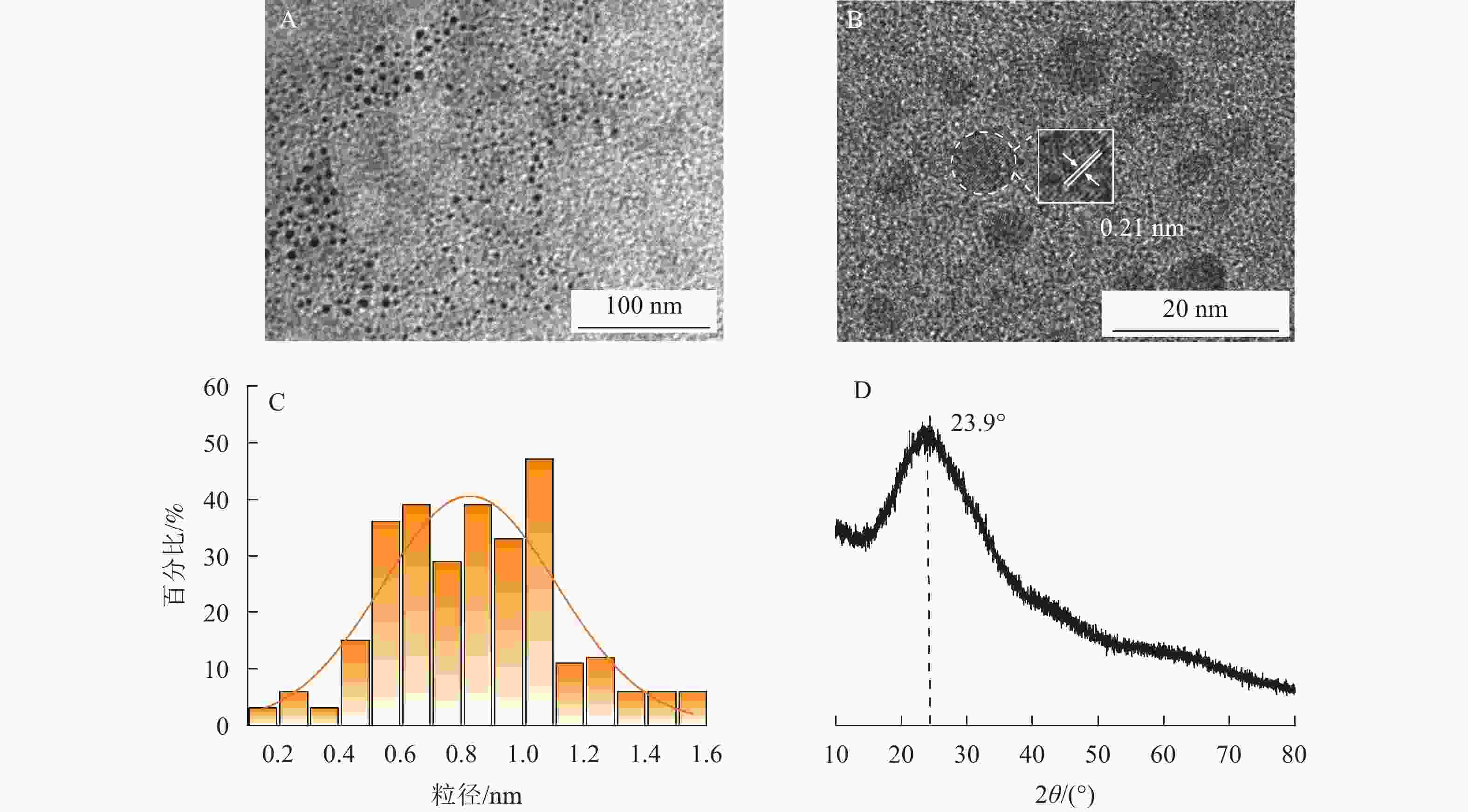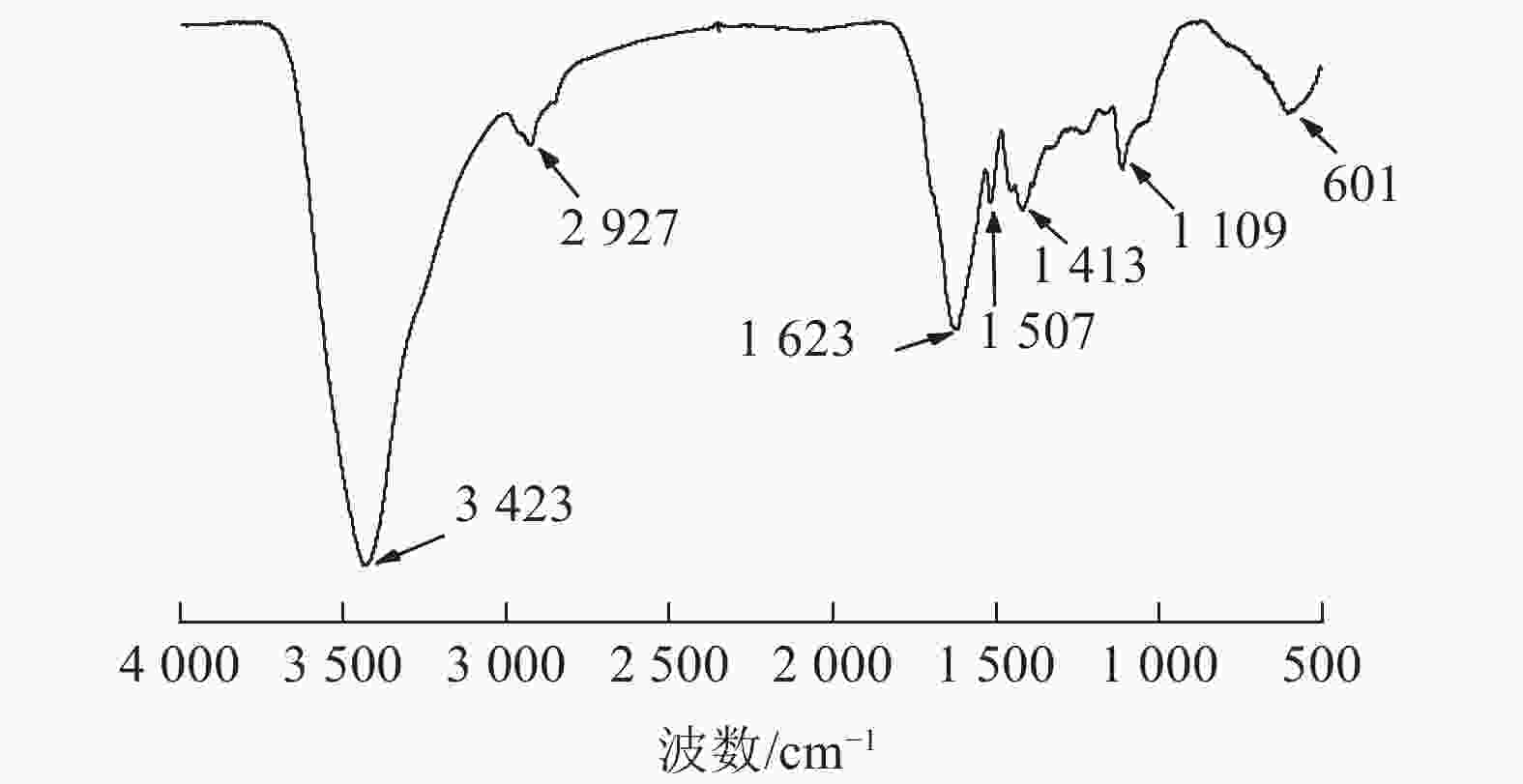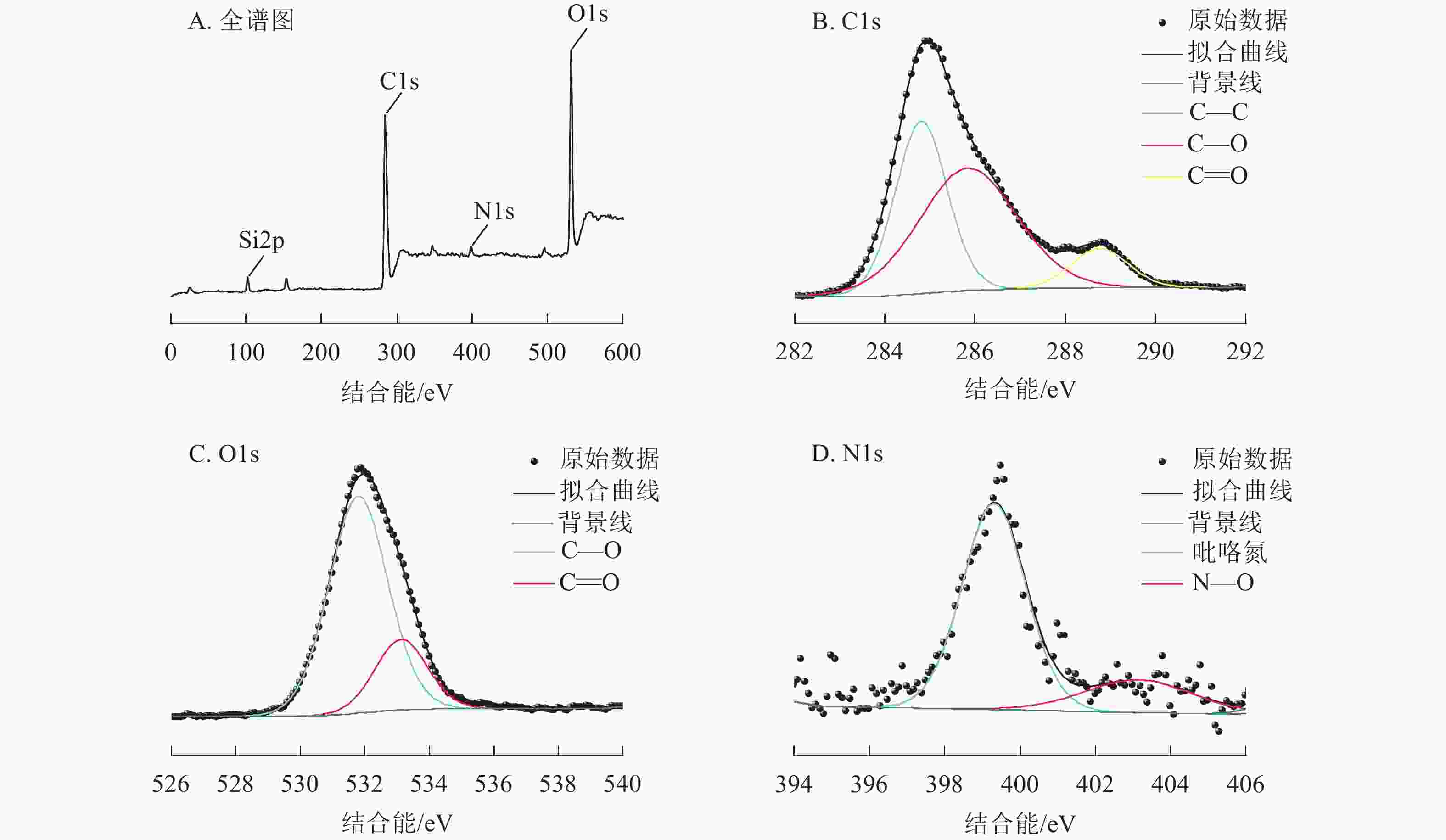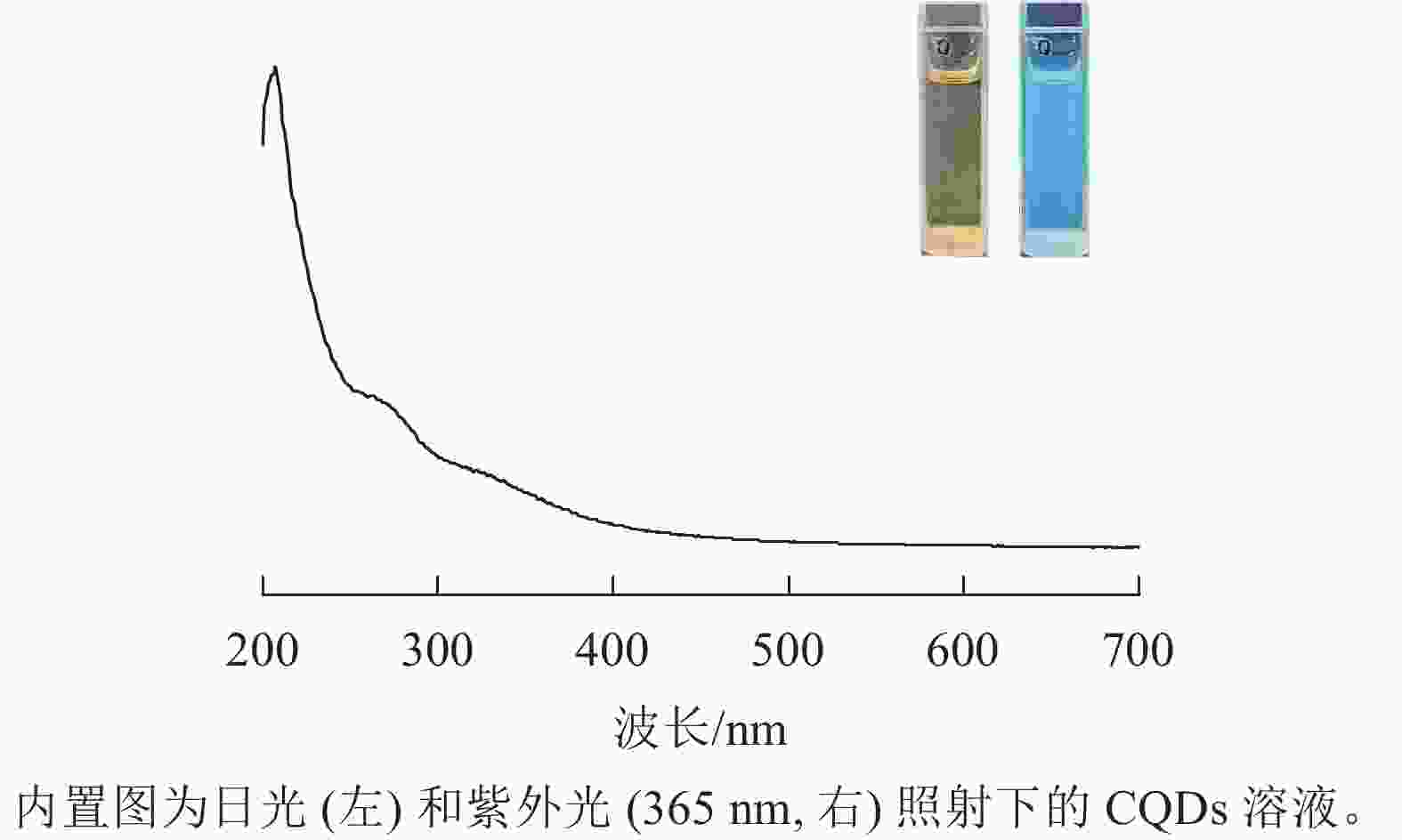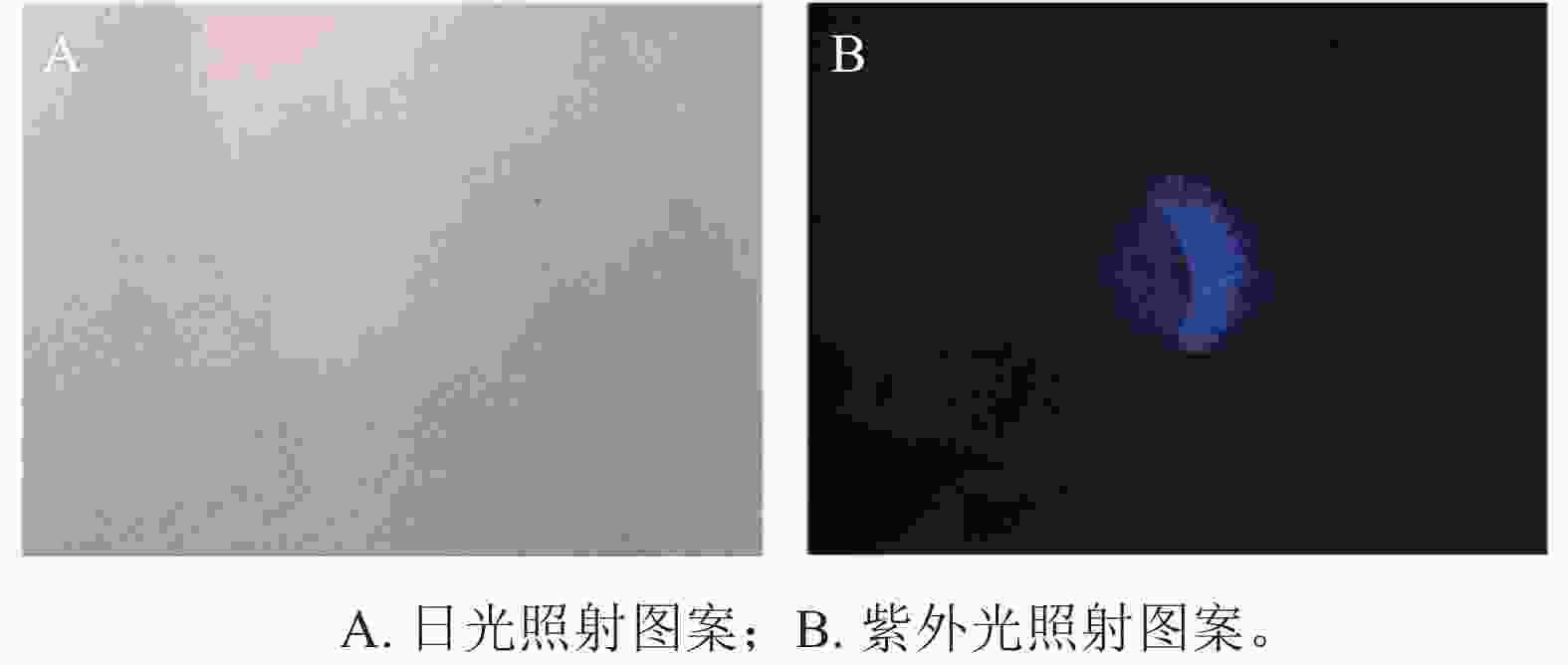-
中国是世界上最主要的产竹国。竹材相比其他生物质材料具有一次成林、储量庞大、生长速度快且经济效益高等优点。然而,竹材利用率低,竹产品附加价值不高[1−3]。竹材砍伐产生的竹梢、竹节、竹枝和竹屑等采伐剩余物以及加工过程中产生的大量竹节隔、竹黄等加工废弃物均未得到合理利用,一般被遗弃在山林或作为普通燃料使用,不仅造成严重的资源浪费,还对环境产生了严重污染[4−6]。因此,高效合理利用竹材加工废弃物,对提高竹材利用率以及经济效益具有一定的价值。竹节隔核心成分为纤维素、半纤维素、木质素,富含碳元素,是制备荧光碳量子点(carbon quantum dots, CQDs)的绿色可持续碳源,无需添加任何化学试剂修饰;竹节隔本身含有的氮、硅元素可通过水热碳化自掺杂到CQDs中,从而提高量子产率和光学性能。竹节隔的高效、绿色利用对竹产业可持续、高质量发展具有重要意义。
CQDs是一种尺寸小于10 nm的新型零维碳纳米材料[7],由于其稳定的光学性能、良好的生物相容性、优异的水溶性、低细胞毒性等诸多特性[8−10],在传感[11]、生物成像[12]、光催化[13]、荧光防伪[14]等领域具有广泛的应用前景。根据工艺条件的不同,CQDs的制备方法通常分为2类:自上而下和自下而上[15]。自上而下制备方法,是通过电弧放电、化学氧化、激光烧蚀等将大尺寸的碳靶剥离或切割成小尺寸的CQDs[16]。但存在设备昂贵、合成条件苛刻等缺陷。自下而上制备方法主要利用微波辅助、水热等将有机小分子前驱体碳化制备得到CQDs[17],在调控CQDs的形状和尺寸等方面具有显著优势。其中,水热法制备CQDs的前驱体来源广泛,但苯二胺、甲酰胺等常用有机化工原料成本昂贵,且部分工艺处理过程繁复,具有一定的毒性,限制了CQDs的应用领域。相比之下,生物质材料具有可再生、成本低廉、环境友好、来源广泛等优点[18−20]。以生物质碳源制备CQDs已成为当前研究热点。AMER等[21]以马齿苋Portulaca oleracea叶为原料,采用一步水热法150 ℃碳化4 h,经过离心、透析等处理后得到绿色荧光碳量子点,并用石英晶体微天平(QCM)检测甲醛等有害气体。近年来,以稻Oryza sativa壳[22]、银杏Ginkgo biloba叶[23]、花生 Arachis hypogaea壳[24]、青稞Hordeum vulgare var. coeleste [25]、枸杞Lycium chinense[26]等生物质材料制备碳量子点,并进一步应用于生物成像、传感器、防伪等诸多领域。目前,以生物质材料为碳源前驱体制备出的CQDs存在荧光颜色单一、荧光量子产率低等问题,仍需进一步探究和优化。
本研究以竹材加工废弃物竹节隔为碳源,采用一步水热法,绿色制备高荧光量子产率的竹节隔CQDs,并探究其在荧光防伪领域应用的可能性,以期提高废弃生物质材料价值,实现竹材加工废弃物的高效利用。
-
3~4年生毛竹Phyllostachys edulis竹节隔通过粉碎、过筛得到100目竹节隔粉末;无水乙醇(分析纯);普通定性滤纸、0.22 μm微孔滤膜、500 Da透析袋购于南京化学试剂有限公司;试验中用于合成和透析的水溶液均为去离子水。
-
分别称取1.0、1.5、2.0、2.5 g的竹节隔粉末分散于25 mL去离子水中,混合均匀后移入50 mL聚四氟乙烯内衬的反应釜中,180 ℃反应10 h。反应结束,待聚四氟乙烯反应釜冷却至室温后取出内胆,用普通定性滤纸进行过滤,之后将CQDs的滤液放入高速冷冻离心机,10 000 r·min−1离心10 min。离心结束后,用0.22 μm微孔膜过滤上清液,去除聚集颗粒使CQDs纯化。采用500 Da透析袋进行48 h透析,去除未反应的小分子,冷冻后放入真空冷冻干燥机进行干燥备用。竹节隔CQDs制备流程见图1。
取0.4 mg CQDs粉末溶于4 mL乙醇溶液中,配置出质量浓度为0.1 g·L−1的CQDs样品溶液,通过瞬态/稳态荧光光谱仪测定:当竹节隔粉末为2 g时,绝对荧光量子产率最高,因此,表征与分析的对象均为竹节隔粉末2 g、去离子水25 mL制备的CQDs。
-
采用透射电子显微镜(JEM-2100F,JEOL公司)和高分辨率透射电子显微镜(JEM-2100UHR, JEOL公司)表征CQDs的形貌与晶格间距;采用X射线衍射(XRD Ultima IV)表征CQDs的晶体性质,测试范围为10°~80°;采用紫外可见光光度计(Lambda950,PE公司)测定CQDs的紫外吸收光谱;采用瞬态/稳态荧光光谱仪(FluoroMax-4,HORIBA公司)测试CQDs最佳激发波长,检测其荧光性能;通过双指数模型计算荧光寿命,并对荧光衰减寿命曲线进行拟合:
$$ {\tau }_{ave}=\frac{{A}_{1}{\tau }_{1}^{2}+{A}_{2}{\tau }_{2}^{2}}{{A}_{1}{\tau }_{1}+{A}_{2}{\tau }_{2}} 。 $$ 其中:$ {\tau }_{\mathrm{a}\mathrm{v}\mathrm{e}} $为平均荧光寿命, $ {A}_{1} $、$ {A}_{2} $为振幅,$ {\tau }_{1} $、$ {\tau }_{2} $为衰减时间。同时,在350 nm激发波长下测试CQDs的绝对荧光量子产率;采用红外光谱仪(VERTEX80V,Bruker公司)表征CQDs的表面官能团状态,波数为500~
4000 cm−1;采用X射线光电子能谱仪(AXIS-Ultra DLD,Shimadzu公司)测定CQDs的元素组成及化学结构。 -
由图2A可以看到:所制备的CQDs呈近圆形颗粒,具有良好的分散性。由图2B高分辨率透射电镜可以看出:CQDs晶格间距为0.21 nm,对应石墨(100)晶面间距[27]。通过ImageJ软件测算可知:CQDs粒径主要分布范围为0~1.6 nm,平均粒径尺寸为0.84 nm (图2C)。CQDs的XRD图谱如图2D:在23.9°出现1个宽衍射峰,属于无定形碳结构的特征峰,对应石墨的(002)晶面[28],宽衍射峰的出现是因为合成的CQDs尺寸较小。分析结果表明:制备的竹节隔CQDs,不仅具有结晶度良好的碳核,也具有无定形表面基团。同时,尺寸较小的CQDs会影响其光致发光性能。在水热过程中,由于CQDs的尺寸分布不一,多重能间隙共同存在,导致荧光发射为激发依赖型。
-
通过红外光谱仪对CQDs的表面官能团进行分析(图3)。在3 423 cm−1处的吸收峰,是由O−H伸缩振动产生的,位于2 927 cm−1处的吸收峰为C−H伸缩振动[29],1 623、
1507 、1413 cm−1处的吸收峰分别为C=O伸缩振动、C=C伸缩振动、C−N拉伸振动[30],表明通过水热反应,氮元素已掺杂到CQDs的碳骨架中。分析结果表明:CQDs表面含有丰富的亲水基团,如羟基、羰基等,故具备优异的水溶性和稳定性[31]。制备的CQDs能够很好地分散于水溶液中,为后续改性提供便利。 -
采用X射线光电子能谱仪进一步检测并分析CQDs的元素组成(图4A)。在284.8、400.0、531.9 eV处显示3个信号峰位,分别对应C1s、N1s、O1s的特征峰,表明制备的CQDs含有碳、氮、氧元素。由元素分析结果可知:碳、氮、氧元素占比依次为67.82%、2.11%、30.07%。CQDs碳元素的C1s经分峰拟合后可以看出(图4B):在284.3、285.6和288.2 eV处有3个峰位,分别对应C−C、C−O和C=O键。氧元素中的O1s经分峰拟合后(图4C),在531.4和532.8 eV处出现2个峰位,分别对应C—O键和C=O键[32]。氮元素中的N1s经分峰拟合后(图4D),在399.3和403.1 eV处的峰位分别对应吡咯氮和N−O键。结果显示:102.0 eV处的信号峰表明CQDs还含有少量的硅元素,证明在其表面成功自掺杂硅元素,可以有效降低CQDs表面的非辐射复合中心数量,减少能量的损失,调节能带结构,促进荧光量子产率的提高。 氮元素的掺杂可以使CQDs表面的官能团种类和数量发生改变,制备的CQDs将具有更加优异的荧光性能。
-
如图5所示:CQDs在紫外可见光吸收光谱图中呈现2个吸收峰,分别位于282和320 nm处,分别是由于CQDs内部芳香sp2区域的π-π*电子跃迁和C=O键的n-π*引起的[33]。CQDs溶液在日光条件下呈现淡黄色,在365 nm紫外灯照射下呈现蓝色荧光。表明制备的CQDs溶液具有良好的荧光效果。
-
如图6A所示:CQDs的荧光光谱随着激发波长增加发生移动,表明竹节隔CQDs荧光发射属于激发依赖性。在激发波长为300~400 nm,每次间隔增量为10 nm的激发光下,荧光强度随着激发光波长的增加呈现出先增长后下降的趋势,激发波长依赖性是由于表面杂原子官能团导致的表面缺陷和尺寸差异[34]而产生的。在380 nm激发光条件下,呈现出较强的蓝色荧光发射,最佳荧光发射峰位位于438 nm。
通过瞬态/稳态荧光光谱仪测定出CQDs的绝对荧光量子产率为6.85%,与已有报道的CQDs量子产率相当[35]。经双指数模型拟合得到荧光衰减曲线(图6B)。可知CQDs的平均荧光寿命为3.64 ns。CQDs发光是由于表面缺陷为了激发能量,在光照下产生辐射复合而引起的。当CQDs粒径较小时,CQDs会表现出较短的发射波长和较高的荧光强度,与透射电镜的表征结果一致。CQDs的激发依赖性有助于优化在荧光防伪领域的应用效果。
-
因为CQDs具有良好的水溶性和荧光特性,所以选择易于挥发的乙醇为介质。将0.1 mg的CQDs粉末溶解于4 mL的乙醇溶液中,在普通定性滤纸上书写。待干燥后,用CQDs乙醇溶液书写的图案在日光下完全不可见(图7A),用365 nm紫外灯照射呈现出明显的蓝色荧光图案(图7B)。图7表明:竹节隔CQDs在防伪领域具有潜在的应用价值。后续将进一步探究由竹节隔CQDs制备的荧光油墨在家具木制品等不同基质上的荧光防伪性能。
-
以竹节隔粉末为前驱体,通过绿色环保、简单的水热法制备出蓝色荧光CQDs。①通过透射电镜表征分析,竹节隔CQDs呈现规则的球形,平均粒径尺寸为0.84 nm,粒径分布范围为0~1.6 nm,且在水中呈现良好的分散性,无团聚现象。②紫外吸收光谱以及荧光光谱图分析可知:CQDs在激发波长380 nm时呈现出较强的蓝色荧光,最佳荧光发射峰位为438 nm。当竹节隔粉末为2.0 g,去离子水为25 mL时,绝对荧光量子产率为6.85%。③红外光谱和X射线能谱图分析表明:水热法制备的CQDs成功掺杂氮和硅元素,且表面带有丰富的亲水基团,具备良好的水溶性和荧光性能。所制备的竹节隔CQDs溶液在日光下不可见,在365 nm紫外灯照射下呈现蓝色荧光,可作为家具荧光防伪的新材料。
Preparation of bamboo carbon quantum dots and their application in fluorescence anti-counterfeiting
-
摘要:
目的 探究竹节隔碳量子点绿色制备方法,提高废弃生物质材料利用效率和附加值。 方法 以竹材废弃物竹节隔为初始碳源,水为溶剂,采用一步水热法制备荧光碳量子点,通过透射电子显微镜、X射线衍射、红外光谱仪、X射线光电子能谱仪、紫外可见光光度计、荧光光谱等表征手段,对竹节隔碳量子点的微观形貌、化学结构和光学特性进行了表征与分析。 结果 所制备的竹节隔碳量子点形状为近圆形,其粒径分布为0~1.6 nm;绝对荧光量子产率为6.85%;具有优异的荧光特性,在365 nm波长紫外灯下呈现明显的蓝色荧光。 结论 制备的竹节隔碳量子点水溶液绿色环保、性能良好,可通过进一步优化设计,以期应用于家具木制品及人造板等木质材料荧光防伪领域。图7参35 Abstract:Objective The objective is to achieve a green method for the preparation of bamboo carbon quantum dots and to improve the utilization efficiency and added value of waste biomass materials. Method Fluorescent carbon quantum dots were prepared by a one-step hydrothermal method using bamboo waste materials (bamboo septa) as the initial carbon source and water as the solvent. The micro-morphology, chemical structure and optical properties of the carbon quantum dots of bamboo septa were characterized and analyzed by means of transmission electron microscopy, X-ray diffraction, infrared spectrometry, X-ray photoelectron spectroscopy, UV-visible photometry and fluorescence spectroscopy. Result The shape of the prepared carbon quantum dots had a near-circular shape, with a size distribution of 0−1.6 nm. The absolute fluorescence quantum yield was 6.85%, and they had excellent fluorescence properties, with a blue fluorescence under a 365 nm ultraviolet lamp. Conclusion The prepared carbon quantum dots aqueous solution is environmentally friendly and has good performance, which can be further optimized for application in the field of fluorescence anti-counterfeiting of wood materials such as furniture wood products and artificial boards. [Ch, 7 fig. 35 ref.] -
Key words:
- bamboo septum /
- carbon quantum dots /
- fluorescence /
- fluorescent anti-counterfeiting
-
[1] 李媛媛, 张双燕, 王传贵, 等. 毛竹采伐剩余物的化学成分、纤维形态及纸浆性能[J]. 浙江农林大学学报, 2019, 36(2): 219−226. LI Yuanyuan, ZHANG Shuangyan, WANG Chuangui, et al. Chemical composition, fiber morphology, and pulping properties of logging residues in Phyllostachys edulis [J]. Journal of Zhejiang A&F University, 2019, 36(2): 219−226. [2] 田华宇, 刘焕, 王国睿, 等. 刺竹活性炭的制备及吸附性能研究[J]. 浙江农林大学学报, 2024, 41(2): 429−436. TIAN Huayu, LIU Huan, WANG Guorui, et al. Production and adsorption properties of activated charcoal from Bambusa sinospinosa [J]. Journal of Zhejiang A&F University, 2024, 41(2): 429−436. [3] 童文瑄, 梁新鑫, 周吓星, 等. KOH共热法和水热活化法制备多孔竹活性炭的比较[J]. 林业工程学报, 2024, 9(2): 77−83. TONG Wenxuan, LIANG Xinxin, ZHOU Xiaxing, et al. Comparation of porous bamboo activated carbon using KOH co-thermal activation and hydrothermal activation methods [J]. Journal of Forestry Engineering, 2024, 9(2): 77−83. [4] 郑龙, 吴义强, 左迎峰. 竹剩余物资源化利用研究现状与展望[J]. 世界林业研究, 2021, 34(3): 82−88. ZHENG Long, WU Yiqiang, ZUO Yingfeng. Research status and prospects of bamboo residues utilization [J]. World Forestry research, 2021, 34(3): 82−88. [5] 曹善郅, 周家树, 张少博, 等. 生物质炭基尿素和普通尿素对毛竹林土壤氧化亚氮通量的影响[J]. 浙江农林大学学报, 2023, 40(1): 135−144. CAO Shanzhi, ZHOU Jiashu, ZHANG Shaobo, et al. Effects of biochar-based urea and common urea on soil N2O flux in Phyllostachys edulis forest soil [J]. Journal of Zhejiang A&F University, 2023, 40(1): 135−144. [6] 闫芳彬, 郑景明, 宫殷婷, 等. 园林废弃物资源化处理对人工林土壤养分及微生物碳源利用的影响[J]. 浙江农林大学学报, 2023, 40(5): 1045−1053. YAN Fangbin, ZHENG Jingming, GONG Yinting, et al. Effects of garden waste reuse treatments on soil nutrients and microbial carbon source utilization in plantation soil [J]. Journal of Zhejiang A&F University, 2023, 40(5): 1045−1053. [7] TIAN Bo, FU Tianxin, WAN Yang, et al. B-and N-doped carbon dots by one-step microwave hydrothermal synthesis: tracking yeast status and imaging mechanism [J/OL]. Journal of Nanobiotechnology, 2021, 19 : 456[2024-04-22]. DOI: 10.1186/s12951-021-01211-w. [8] CHEN Kui, QING Weixia, HU Weiping, et al. On-off-on fluorescent carbon dots from waste tea: their properties, antioxidant and selective detection of CrO4 2−, Fe3+, ascorbic acid and L-cysteine in real samples [J]. Spectrochimica Acta Part A: Molecular and Biomolecular Spectroscopy, 2019, 213: 228−234. [9] ŠAFRANKO S, STANKOVIĆ A, HAJRA S, et al. Preparation of multifunctional N-doped carbon quantum dots from citrus clementina peel: investigating targeted pharmacological activities and the potential application for Fe3+ sensing [J/OL]. Pharmaceuticals, 2021, 14 (9): 857[2024-04-22]. DOI: 10.3390/ph14090857. [10] GIORDANO M G, SEGANTI G, BARTOLI M, et al. An overview on carbon quantum dots optical and chemical features [J/OL]. Molecules, 2023, 28 (6): 2772[2024-04-22]. DOI: 10.3390/molecules28062772. [11] LI Weidong, LIU Yuan, WANG Boyang, et al. Kilogram-scale synthesis of carbon quantum dots for hydrogen evolution, sensing and bioimaging [J]. Chinese Chemical Letters, 2019, 30(12): 2323−2327. [12] YOUNIS M R, HE Gang, LIN Jing, et al. Recent advances on graphene quantum dots for bioimaging applications [J/OL]. Frontiers in Chemistry, 2020, 8 : 424[2024-04-22]. DOI: 10.3389/fchem.2020.00424. [13] ZHAO Yushuang, JING Shuangshuang, PENG Xinwen, et al. Synthesizing green carbon dots with exceptionally high yield from biomass hydrothermal carbon [J]. Cellulose, 2020, 27: 415−428. [14] KALYTCHUK S, WANG Yu, POLÁKOVÁ K, et al. Carbon dot fluorescence-lifetime-encoded anti-counterfeiting [J]. ACS Applied Materials & Interfaces, 2018, 10(35): 29902−29908. [15] LI Jiurong, GONG Xiao. The emerging development of multicolor carbon dots [J/OL]. Small, 2022, 18 (51): 2205099[2024-04-22]. DOI: 10.1002/smll.202205099. [16] LIANG Lili, VEKSHA A, AMRAD M Z B M, et al. Upcycling of exhausted reverse osmosis membranes into value-added pyrolysis products and carbon dots [J/OL]. Journal of Hazardous Materials, 2021, 419 : 126472[2024-04-22]. DOI: 10.1016/j.jhazmat.2021.126472. [17] LIU Huaxin, ZHONG Xue, PAN Qing, et al. A review of carbon dots in synthesis strategy [J/OL]. Coordination Chemistry Reviews, 2024, 498 : 215468[2024-04-22]. DOI: 10.1016/j.ccr.2023.215468. [18] WU Ying, LI Yadong, PAN Xiaoqin, et al. Hemicellulose-triggered high-yield synthesis of carbon dots from biomass [J]. New Journal of Chemistry, 2021, 45(12): 5484−5490. [19] 万才超, 柴亚玲, 魏松, 等. 生物质基炭材料在染料敏化太阳能电池电极领域的研究进展[J]. 林业工程学报, 2023, 8(5): 1−12. WAN Caichao, CHAI Yaling, WEI Song, et al. Research progress of biomass-based carbon materials in dye-sensitized solar cells’ electrodes [J]. Journal of Forestry Engineering, 2023, 8(5): 1−12. [20] 张立丹, 霍鹏举, 梁嘉敏, 等. 生物质基木醋液的制备工艺和增效技术研究进展[J]. 林业工程学报, 2023, 8(5): 27−36. ZHANG Lidan, HUO Pengju, LIANG Jiamin, et al. Research progress on preparation process and synergistic technology of biomass-based wood vinegar [J]. Journal of Forestry Engineering, 2023, 8(5): 27−36. [21] AMER W A, REHAB A F, ABDELGHAFAR M E, et al. Green synthesis of carbon quantum dots from purslane leaves for the detection of formaldehyde using quartz crystal microbalance [J]. Carbon, 2021, 179: 159−171. [22] THONGSAI N, TANAWANNAPONG N, PRANEERAD J, et al. Real-time detection of alcohol vapors and volatile organic compounds via optical electronic nose using carbon dots prepared from rice husk and density functional theory calculation [J]. Colloids and Surfaces A: Physicochemical and Engineering Aspects, 2019, 560: 278−287. [23] MOU Zihao, YANG Qingbin, ZHAO Bin, et al. Scalable and sustainable synthesis of carbon dots from biomass as efficient friction modifiers for polyethylene glycol synthetic oil [J]. ACS Sustainable Chemistry & Engineering, 2021, 9(44): 14997−15007. [24] LIU Yinghui, ZHU Chong, GAO Ying, et al. Biomass-derived nitrogen self-doped carbon dots via a simple one-pot method: physicochemical, structural, and luminescence properties [J/OL]. Applied Surface Science, 2020, 510 : 145437[2024-04-22]. DOI: 10.1016/j.apsusc.2020.145437. [25] XIE Yadian, CHENG Dandan, LIU Xingliang, et al. Green hydrothermal synthesis of N-doped carbon dots from biomass highland barley for the detection of Hg2+ [J/OL]. Sensors, 2019, 19 (14): 3169[2024-04-22]. DOI: 10.3390/s19143169. [26] GU Lin, ZHANG Jingru, YANG Guangxin, et al. Green preparation of carbon quantum dots with wolfberry as on-off-on nanosensors for the detection of Fe3+ and l-ascorbic acid [J/OL]. Food Chemistry, 2022, 376 : 131898[2024-04-22]. DOI: 10.1016/j.foodchem.2021.131898. [27] 张利洁, 李德刚, 韩文渊, 等. 磷掺杂碳量子点的制备及活化过一硫酸盐降解亚甲基蓝[J]. 无机盐工业, 2024, 56(1): 126−133. ZHANG Lijie, LI Degang, HAN Wenyuan, et al. Preparation of phosphorus-doped carbon quantum dots and activation of peroxymonosulfate for degradation of methylene blue [J]. Inorganic Chemicals Industry, 2024, 56(1): 126−133. [28] LIU Yushan, WU Peng, WU Xueyun, et al. Nitrogen and copper(Ⅱ) co-doped carbon dots for applications in ascorbic acid determination by non-oxidation reduction strategy and cellular imaging [J/OL]. Talanta, 2020, 210 : 120649[2024-04-22]. DOI: 10.1016/j.talanta.2019.120649. [29] MURUGAN N, PRAKASH M, JAYAKUMAR M, et al. Green synthesis of fluorescent carbon quantum dots from Eleusine coracana and their application as a fluorescence ‘turn-off’ sensor probe for selective detection of Cu2+ [J]. Applied Surface Science, 2019, 476: 468−480. [30] DESA S S, ISHII T, NUEANGNORAJ K. Sulfur-doped carbons from durian peels, their surface characteristics, and electrochemical behaviors [J]. ACS Omega, 2021, 6(38): 24902−24909. [31] 刘凯, 胡妙言, 高诗雨, 等. 木质素荧光碳点-聚乙烯醇薄膜湿度传感器的制备及性能[J]. 林业工程学报, 2023, 8(3): 114−122. LIU Kai, HU Miaoyan, GAO Shiyu, et al. Preparation and properties of lignin fluorescent CDs-PVA film humidity sensor [J]. Journal of Forestry Engineering, 2023, 8(3): 114−122. [32] BHATI K, TRIPATHY D B, DIXIT A K, et al. Waste biomass originated biocompatible luorescent graphene nano-sheets for latent fingerprints detection in versatile surfaces [J/OL]. Catalysts, 2023, 13 (7): 1077[2024-04-22]. DOI: 10.3390/catal13071077. [33] LIU Zhixiong, YE Y W, CHEN H. Corrosion inhibition behavior and mechanism of N-doped carbon dots for metal in acid environment [J/OL]. Journal of Cleaner Production, 2020, 270 : 122458[2024-04-22]. DOI: 10.1016/j.jclepro.2020.122458. [34] SHEN Dongjun, LONG Yijuan, WANG Jie, et al. Tuning the fluorescence performance of carbon dots with a reduction pathway [J]. Nanoscale, 2019, 11(13): 5998−6003. [35] JEONG G, PARK C H, YI Dongchan, et al. Green synthesis of carbon dots from spent coffee grounds via ball-milling: application in fluorescent chemosensors [J/OL]. Journal of Cleaner Production, 2023, 392 : 136250[2024-04-22]. DOI: 10.1016/j.jclepro.2023.136250. -

-
链接本文:
https://zlxb.zafu.edu.cn/article/doi/10.11833/j.issn.2095-0756.20240361






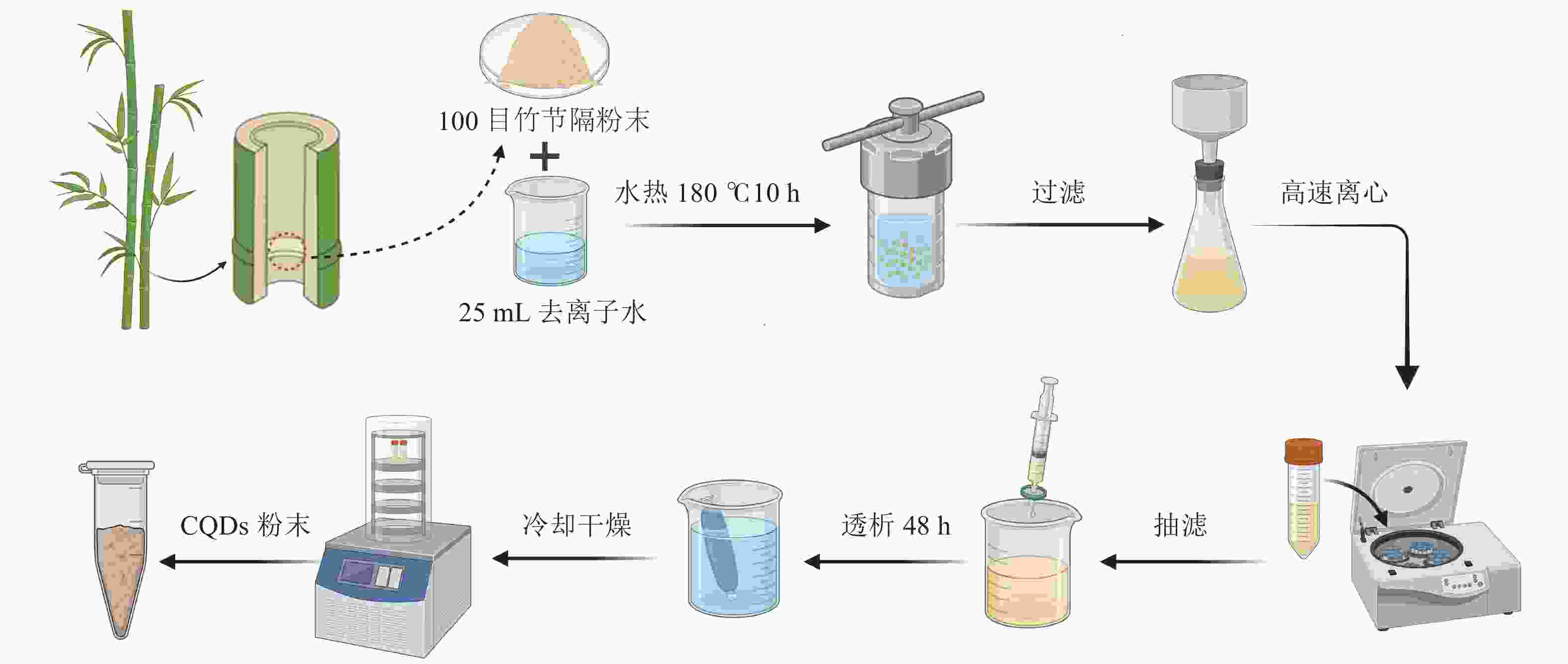
 下载:
下载:
